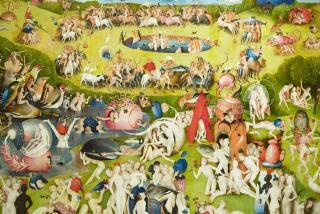Vanishing Act : IN THE LAKE OF THE WOODS, <i> By Tim O’Brien (Houghton Mifflin: $21.95; 306 pp.)</i>
- Share via
The German writer Theodore Adorno questioned whether art could survive the Holocaust. The new novel by Tim O’Brien, author of “Going After Cacciato” and “The Things They Carried,” raises a similar question. It carries the suggestion that no human project can survive the contamination of exposure to the Vietnam War: not the political ambitions and private sanity of the veteran who is the novel’s protagonist, and perhaps not even the possibility that O’Brien, who wrote so brilliantly about the war, will be able to write his way out of it.
“In the Lake of the Woods” tries to tell the story of John Wade, a young Minnesota politician whose promising race for the Senate is stopped dead by the revelation that he covered up his membership in the Army company that butchered the inhabitants of My Lai. As a child, Wade was a dedicated practitioner of magic and disappearing tricks. His candidacy, in what it concealed, was another disappearing trick. And when he and his wife, Kathy, retreat to a lakeside cabin in the north woods to recover, Kathy disappears.
When I say O’Brien “tries” to tell the story, I do not mean that he has necessarily failed in his intention. In a sense, he may have intended to fail. He sets up two related stories: that of a political chameleon who does not so much violate the truth as make it vanish, even for himself; and a darkly gruesome mystery about what happened to Kathy. But the two stories are hostages of the bloody presence of Vietnam, waiting in a back room.
They speak under constraint. The story of Wade’s childhood, marriage and career is formulaic and desultory; whereas the mystery of the disappearance, written more powerfully, blurs in the nightmarish mutter from behind the door. It is as if O’Brien were telling us that even fictionally, there is no possibility of connecting Vietnam with anything that follows; as if it were a kind of antimatter that annihilates any story that tries to build from it.
O’Brien’s back room is a group of chapters that alternate with the story of Wade and Kathy. They consist of pages of quotes. Some are from fictional witnesses to the fictional story. Others consist of press reports and trial testimony about the My Lai affair, and of passages from books about the stress of combat, and from memoirs of atrocities committed in other American wars.
Underneath these, as footnotes, comes O’Brien’s own passionate voice; not as narrator but as a man who was there. He comments on his story, at least on that part of the story in which the fictional Wade takes part in the historical massacre. And the book’s key passage occurs not in the fiction, but in the footnote. Here it is, in part:
“I know how it happened. I know why. It was the sunlight. It was the wickedness that soaks into your blood and slowly heats up and begins to boil. Frustration, partly. Rage, partly. The enemy was invisible. They were ghosts. . . . But, it went beyond that. Something more mysterious. The smell of incense, maybe. The unknown, the unknowable. The blank faces. The overwhelming otherness. This is not to justify what occurred on March 16, 1968, for in my view, such justifications are both futile and outrageous. Rather, it’s to bear witness to the mystery of evil. Twenty-five years ago, as a terrified young PFC, I too could taste the sunlight. I could smell the sin. I could feel the butchery sizzling like grease just under my eyeballs.”
Such a voice drastically overshadows the fiction designed to embody its message. Except in his nightmares, Wade is an uninteresting, sketchy cliche; and Kathy exists thinly as someone who sees through him but loves him anyway. He is not, in fact, one of the real villains of My Lai. He shoots one civilian, but it was because he mistook a hoe for a gun. The other man he kills is one of the bloodiest of his fellow soldiers, who approaches him after he collapses into a ditch, sickened by what he has seen.
If Wade is loathsome, in fact, it is insofar as he is designed to represent the slickness and superficiality of a national public morality. Wade as the soldier who re-enlists after the massacre, gets a spot as battalion clerk and expunges his own company records, as a politician who conceals his past: all these are part of the universal spin that depends on obliterating history in order to be able, comfortably, to repeat it.
Wade pays for his cover-up by being found out and losing shamefully his race for the Senate. But the real price is internal. He no longer is capable of remembering, of distinguishing what he has done from what he wants to appear to have done. His punishment comes when Kathy disappears. As the sheriff cautiously and fruitlessly investigates, O’Brien dramatizes a series of hypotheses. They range from the routine--she has simply decided to leave him, taking their boat--to the bloodier--she has struck a shoal and drowned--to the monstrous--in a Vietnam-vintage nightmare, Wade has killed her in a manner too horrible to describe here--to the possibility, after Wade himself vanishes, that they have staged a two-part flight.
To disappear and to make truth disappear is to enter a wasteland of moral anarchy in which even the most hellish actions are conceivable. O’Brien narrates each version of what Wade has done in equally firm detail. Thematically, this is appropriate, but it makes for an artistic botch. Suspense, like suspension bridges, needs pillars to rest on. With his memory x’d out--and with O’Brien, in order to emphasize his character’s spiritual anomie, refusing to supply a memory for him--what Wade has or has not done is of relatively little interest. This is particularly so, since the author has taken so few pains to make him, before and after the killing field, in any way distinctive.
More to Read
Sign up for our Book Club newsletter
Get the latest news, events and more from the Los Angeles Times Book Club, and help us get L.A. reading and talking.
You may occasionally receive promotional content from the Los Angeles Times.






